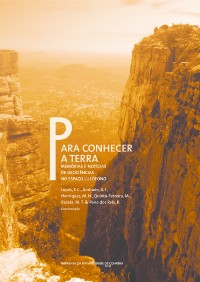Please use this identifier to cite or link to this item:
https://hdl.handle.net/10316.2/31396| Title: | O Graben de Palestina (Bacia do Araripe, NE Brasil): análise estratigráfica | Other Titles: | The Palestina Graben (Araripe Basin, NE Brazil): stratigraphic analysiss | Authors: | Cardoso, F. M. C. Sá, E. F. Jardim de Scherer, C. M. S. Córdoba, V. C. |
Keywords: | Araripe Basin;NE Brazil;Sedimentary facies;Bacia do Araripe;NE Brasil;Fácies sedimentares | Issue Date: | 2012 | Publisher: | Imprensa da Universidade de Coimbra | Journal: | http://hdl.handle.net/10316.2/24406 | Abstract: | The Palestina Graben is one of the NE-trending asymmetric Grabens of the
Araripe Basin, in the eastern portion of the Araripe Basin. The stratigraphy in this domain
comprises three distinct tectonosequences, the older two preceding the Eocretaceous rifting that
developed the Eastern brazilian margin. The Paleozoic Syneclise Tectonosequence corresponds
to Mauriti Formation, related to a braided fluvial system. The Jurassic Tectonosequence,
represented by the Brejo Santo Formation, was originated in a distal floodplain of ephemeral
fluvial channels. The Rift Tectonosequence comprises: (i) the lower section of the Missão
Velha Formation, associated to a braided to meandering fluvial system during an early rifting
stage; (ii) the upper section of the Missão Velha Formation, separated from the former one by
a major unconformity and related to a braided fluvial system; and (iii) the Abaiara Formation, representing the rift climax and originated by a deltaic system fed by a meandering
fluvial system O Graben de Palestina faz parte do conjunto de Grabens assimétricos com orientação NE-SW a ENE, na porção leste da Bacia do Araripe. A estratigrafia neste domínio é representada por três tectonossequências distintas, sendo que as duas primeiras fazem parte de um contexto precedente ao rifte eocretáceo, que moldou a margem continental leste brasileira. A Tectonossequência da Sinéclise Paleozóica corresponde à Formação Mauriti, relacionada a um sistema fluvial entrelaçado. A Tectonossequência Jurássica, representada pela Formação Brejo Santo, foi originada numa planície de inundação distal de canais fluviais efêmeros. A Tectonossequência Rifte inclui: (i) a secção inferior da Formação Missão Velha, associada a um sistema fluvial entrelaçado a meandrante grosso, numa etapa inicial o rifte; (ii) a secção superior da Formação Missão Velha, separada da anterior por uma importante discordância e relacionada a um sistema fluvial entrelaçado; e (iii) a Formação Abaiara, representando o clímax do rifte e originada por um sistema deltaico alimentado por um sistema fluvial meandrante. |
URI: | https://hdl.handle.net/10316.2/31396 | ISBN: | 978-989-26-0534-0 (PDF) | DOI: | 10.14195/978-989-26-0534-0_10 | Rights: | open access |
| Appears in Collections: | Para conhecer a Terra: memórias e notícias de Geociências no espaço lusófono |
Files in This Item:
| File | Description | Size | Format | |
|---|---|---|---|---|
| 10-para_conhecer_a_terra_artigo.pdf | 1.08 MB | Adobe PDF |  |
Items in DSpace are protected by copyright, with all rights reserved, unless otherwise indicated.
